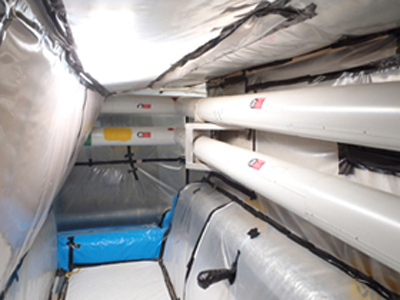Air Monitoring can identify and measure asbestos exposure risks, and in many cases is a legal requirement.
Air monitoring is typically undertaken to show work processes are not generating airborne asbestos fibres, or provide evidence that an area is safe to re-occupy after asbestos works, or accidental disturbance of ACMs.
Our experienced and licensed Asbestos Assessors can advise if air monitoring is appropriate in the first instance, and the type and frequency of sampling. It’s important to note that a visual inspection of an area, or the condition of suspect materials, can often be more effective and cost efficient in identifying potential exposure risks.
Asbestos air monitoring may be conducted for a variety of reasons, and there are four main types of monitoring that fit most requirements. A combination of different monitoring types may be used at the same time.
- Clearance Monitoring
- Control or Leak Monitoring
- Background Monitoring
- Personal Monitoring
All air monitoring results are issued as NATA (National Association of Testing Authorities) accredited Analysis Certificates.
Clearance Monitoring
After works with friable (higher-risk) asbestos materials in the workplace, Clearance Air Monitoring is required.
Clearance monitoring, in conjunction with a thorough visual inspection, provides evidence that an area is safe for reoccupation.
Satisfactory results of Clearance monitoring, and a Visual Clearance inspection, must be documented in a Clearance Certificate.


Control / Leak Monitoring
During asbestos works, Control Monitoring is undertaken to confirm control measures are working, detect leaks in an enclosure, and check filters on negative air pressure units are intact.
Elevated fibre levels identified through control monitoring indicate that additional actions need to be taken, and works must be stopped until the issue is identified and addressed.
On completion of asbestos works, Clearance Monitoring will usually be required.
Background Monitoring
If there are concerns an area may be contaminated with airborne asbestos if, for example, suspect materials have been damaged or disturbed, Background Monitoring can assist with the risk assessment process.
Background Monitoring would usually be conducted in conjunction with a visual inspection of the area, to identify damaged materials or potential sources of airborne fibres.
Background monitoring may be periodically conducted in an area with higher-risk asbestos materials present, to provide reassurrance to all stakeholders that airborne asbestos had not presented an exposure risk over time.


Personal Monitoring
Personal Monitoring measures airborne fibre concentrations in the immediate vicinity of persons involved with asbestos works, or who risk disturbing asbestos during non-asbestos works.
Personal monitoring may be conducted to provide evidence that work processes are not generating airborne asbestos fibres, or to quantify potential exposure risks and determine if additional controls are required.
If there is any risk airborne asbestos fibres might be present, workers should be using suitable Personal and Respiratory Protective Equipment (PPE & RPE).
